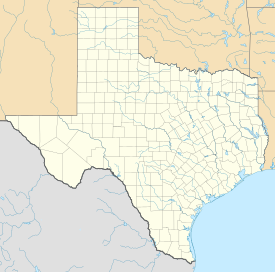Mission Nuestra Señora del Espíritu Santo de Zúñiga
| Mission Nuestra Señora del Espíritu Santo de Zúñiga | |
|---|---|

The chapel of Mission Nuestra Señora del Espíritu Santo de Zúñiga.
|
|
| Basic information | |
| Location |
Goliad, Texas |
| Geographic coordinates | 28°39′15″N 97°23′07″W / 28.654253°N 97.385259°WCoordinates: 28°39′15″N 97°23′07″W / 28.654253°N 97.385259°W |
| Affiliation | Roman Catholic |
| Country | United States of America |
| Architectural description | |
| Architectural style | Spanish Colonial |
| Completed | Founded 1722 |
| Materials | stone and mortar |
| U.S. National Register of Historic Places | |
| Added to NRHP | August 22, 1977 |
| NRHP Reference no. | 77001446 |
Mission Nuestra Señora del Espíritu Santo de Zúñiga, also known as Aranama Mission or Mission La Bahia, was a Roman Catholic mission established by Spain in 1722 in the Viceroyality of New Spain—to convert native Karankawa Indians to Christianity. Together with its nearby military fortress, Presidio La Bahia, the mission upheld Spanish territorial claims in the New World against encroachment from France. The third and final location near Goliad, Texas is maintained now as part of Goliad State Park and Historic Site.
Established on 1722 on Matagorda Bay near La Salle's Fort Saint Louis on Garcitas Creek,as the mission and complementing presidio the fort was intended to secure the Texas coastline from the French and to gather the local Cocos, Copanes, and Cujanes. Being unable to attract the Indians to stay at the mission and due to violence with the Spanish soldiers, the mission was relocated only four years later, to a more favorable location on the Guadalupe River. Artifacts from this settlement are currently on display at the Museum of the Coastal Bend in Victoria.
Moved in 1726 near Victoria, the mission was established among the Tamique and Aranama Indians in Mission Valley. Dams and stone acequias were built to carry water from the river to the mission. A ranching outpost was also built of mortar and stone at Tonkawa Bank, on the river about 12 miles below. The presidio also followed and was built at what was later to become Fernando De Leon's Ranch. The establishment prospered for 26 years, producing enough grain and hay to trade with other Spanish settlements. It was at this time that the foundation for cattle and horse ranching started. Although prosperous, Spanish officials recommended moving the mission to secure the area between Bexar and East Texas from the encroachment of the French and English.
...
Wikipedia

